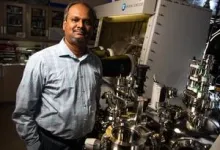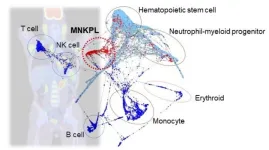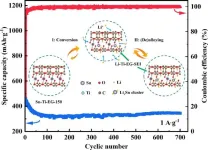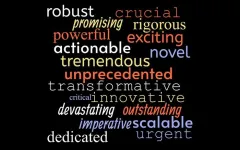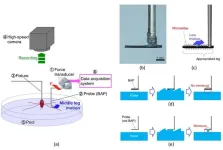(Press-News.org) The urgent need to meet global clean energy goals has world leaders searching for faster solutions. To meet that call, the Department of Energy’s Pacific Northwest National Laboratory has teamed with Microsoft to use high-performance computing in the cloud and advanced artificial intelligence to accelerate scientific discovery on a scale not previously demonstrated. The initial focus of the partnership is chemistry and materials science—two scientific fields that underpin solutions to global energy challenges.
“The intersection of AI, cloud and high-performance computing, along with human scientists, we believe is key to accelerating the path to meaningful scientific results,” said PNNL’s Deputy Director for Science and Technology Tony Peurrung. “Our collaboration with Microsoft is about making AI accessible to scientists. We see the potential for AI to surface a material or an approach that is unexpected or unconventional, yet worth investigating. This is a first step in what promises to be an interesting journey to accelerate the pace of scientific discovery.”
How is this AI development different?
The two organizations are laser-focused on leveraging what AI does best—synthesizing billions of information bits—more than any human could possibly absorb—and quickly presenting conclusions based on its analysis. Microsoft’s Azure Quantum Elements platform uses advanced AI models purpose-built to aid scientific discovery. PNNL researchers are now testing its ability to identify promising new materials for energy applications. The two organizations have committed to leveraging advanced AI models to find viable new materials and the chemistries needed to provide energy-on-demand while preserving the Earth’s resources for future generations.
“We are at the dawn of a new era of scientific discovery that can transform our world for the better. With novel AI and hyperscale capabilities, we can speed up research and unlock the discovery of new molecules that can address some of the most pressing issues of our time, from clean energy to eliminating toxic chemicals and beyond. We are honored to work with world-class scientific institutions like Pacific Northwest National Laboratory. Our breakthrough in using AQE to find new battery materials is just one of the many examples of how our innovative approach to materials research can improve our daily lives,” said Jason Zander, Executive Vice President of Strategic Missions and Technologies at Microsoft.
Energy storage as a test case
The newly executed agreement between the two organizations formalizes the next phase of PNNL’s ongoing relationship with Microsoft. Over the next several years, the Microsoft-PNNL partnership envisions a transformative journey toward pioneering breakthroughs in scientific discovery and sustainable energy—leveraging cutting-edge computing and artificial intelligence technologies to address some of the world's most pressing challenges. The partnership will have an initial emphasis in computational chemistry and material science.
about how PNNL created these new energy storage materials in PNNL’s Energy Sciences Center. There, materials scientists Vijay Murugesan, Shannon Lee, Dan Thien Nguyen and Ajay Karakoti synthesized and tested the new compound. The entire process, from receiving the simulated candidates through producing a functioning battery, took less than nine months, a blink of an eye compared with traditional methods. To make the compound competitive with published benchmarks, additional optimization is required and initial investigations suggest new pathways to further explore the functional properties of the new material.
“The new battery results are just one example—a proof point if you will,” said PNNL’s Chief Digital Officer Brian Abrahamson. “We recognized early on that the magic here is in the speed of AI assisting in the identification of promising materials, and our ability to immediately put those ideas into action in the laboratory. We are excited to take this to the next level in the partnership between Microsoft and PNNL. We plan to push the boundaries of what's possible through the fusion of cutting-edge technology and scientific expertise.”
END
PNNL kicks off multi-year energy storage, scientific discovery collaboration with Microsoft
The imperative to move faster from research to application of energy solutions gets a boost with AI trained to dramatically accelerate scientific discovery
2024-01-09
ELSE PRESS RELEASES FROM THIS DATE:
The hidden identity of leukemia
2024-01-09
Researchers from Tokyo Medical and Dental University (TMDU) use various technologies to better characterize a rare form of leukemia on the molecular level
Tokyo, Japan – Leukemia is a common term used to refer to a form of blood cancer. However, there are different types of leukemia depending on the cell type involved. One unique form is myeloid/natural killer (NK) cell precursor acute leukemia (MNKPL). Because of its rarity, there is no consensus on the specific characteristics needed to clinically identify this disease. In a recent article ...
Unique framework of tin bimetal organic compound facilitates stable lithium-ion storage
2024-01-09
Battery capacity is one of the primary bottlenecks in efficient renewable energy storage and significant reductions in carbon emissions. As a battery anode that releases electrons in a lithium-ion battery (LIB), tin (Sn) and Sn-mixture alloys could theoretically store more energy at a higher density than more common carbon-based anodes. Pairing a Sn-Ti bimetal element with inexpensive ethylene glycol (Sn-Ti-EG) mitigated many of the challenges of using Sn as an anode material and produced an inexpensive LIB with excellent storage and performance characteristics.
Sn and Sn alloys, or mixture of another metal with Sn, could outperform other anode materials ...
Attribution of the extreme drought in eastern China in 2022 and its future risk
2024-01-09
Eastern China was hit by an extreme drought in summer 2022 that caused severe economic and agricultural damage. The event has attracted a great deal of attention not only because of its severe intensity and huge social impacts, but also because it is yet another example within the hot topic of the influence of anthropogenic forcing induced warming on drought extremes and how they might change under different scenarios of continued warming in the future.
Recently, Atmospheric and Oceanic Science Letters published ...
Increasing levels of "hype" language in grant applications and publications
2024-01-09
Tsukuba, Japan—The success of scientific endeavors often depends on support from public research grants. Successful applicants increasingly describe their proposed research using promotional language ("hype"); however, it remains unclear whether they use hype in their subsequent research publications.
A research team led by the University of Tsukuba analyzed all published research abstracts of projects funded by the US National Institute of Health (NIH) from 1985 to 2020. The analysis covered 139 hype adjectives emphasizing significance ...
Is spa water a fossil of water? Uncover the real ultra-deep water cycles
2024-01-09
Tsukuba, Japan—Although most natural spa waters primarily originate from atmospheric precipitation, such as rain and snow (known as meteoric water), the present study explored the unique qualities of certain spa waters. By analyzing the stable isotope compositions of hydrogen and oxygen in water molecules, researchers have identified distinct characteristics that indicate the presence of long-trapped lithospheric water. They traced the isotopic evolution of this water through sophisticated numerical modeling, and found that various types of water, including those found deep beneath the ...
Light measurement enables estimation of the chemical attributes of spice extracts
2024-01-09
Tsukuba, Japan—Spices and other plant-derived products contain many active components, such as polyphenols and flavonoids. However, even the slightest variations in conditions can considerably affect the extraction efficiency of these active components, posing challenges in determining the exact quantity of active components in the extract solution.
In this study, researchers comprehensively measured the fluorescence emitted by polyphenols and flavonoids and analyzed the acquired data using machine learning methods. ...
Nemours Children’s Health researchers find Zika virus is effective when used to treat a type of childhood cancer in mice
2024-01-09
ORLANDO, Fla. (Jan. 9, 2024) — Injecting neuroblastoma tumors with Zika virus shrank or eliminated those tumors in studies with mice, suggesting that the virus could someday serve as an effective cancer therapy, according to a study led by Nemours Children’s Health researchers and published today in Cancer Research Communications, a journal of the American Association for Cancer Research.
Neuroblastoma is a rare childhood cancer that typically develops in the sympathetic nervous system or the adrenal glands. Only 700 to 800 cases are diagnosed each year in the United States, accounting for ...
Multidisciplinary panel advocates for increased adoption of Intravascular Ultrasound (IVUS) in peripheral vascular interventions
2024-01-09
EMBARGOED UNTIL 10:00 AM ET ON JANUARY 9, 2024
WASHINGTON (January 9, 2024) – Proceedings from an expert consensus roundtable that discussed the benefits of intravascular ultrasound (IVUS) in lower extremity revascularization procedures were released today in the Journal of the Society for Cardiovascular Angiography & Interventions (JSCAI), Journal of Vascular and Interventional Radiology (JVIR), and Journal of Vascular Surgery - Vascular Insights.
The roundtable focused on the current challenges in diagnosing ...
Analysis of rowing force of the water strider middle leg by direct measurement using a bio-appropriating probe and by indirect measurement using image analysis
2024-01-09
A research paper by scientists at the Ibaraki University analyzed the rowing force of the water strider middle leg by direct measurement using a bio-appropriating probe and by indirect measurement using image analysis.
The new research paper, published on Nov. 17 in the journal Cyborg and Bionic Systems, reported the rowing force of water striders obtained by direct and indirect measurements, and analyzed the maximum force arrival time and the middle leg angular velocity of the direct and indirect force measurements.
“Rowing force of the middle leg of a water ...
Discovering a new mechanism of vestibular neuritis
2024-01-09
Prof. Sun-Uk Lee of the Department of Neurology and Prof. Euyhyun Park of the Department of Otorhinolaryngology from Korea University’s Anam Hospital discovered a new mechanism of vestibular neuritis.
Vestibular neuritis is one of the common diseases causing acute dizziness. It is known to be caused by an inflammation in the vestibular nerve and inner ear, which is responsible for balance and body motion sensation.
Various mechanisms had been suggesting as the cause of vestibular neuritis, such as reactivation of latent herpes virus or peripheral blood circulation disorder in the ...
LAST 30 PRESS RELEASES:
Scientists trace microplastics in fertilizer from fields to the beach
The Lancet Obstetrics, Gynecology, & Women’s Health: Taking paracetamol during pregnancy does not increase risk of autism, ADHD or intellectual disabilities, confirms new gold-standard evidence review
Taking paracetamol during pregnancy does not increase risk of autism, ADHD or intellectual disabilities
Harm reduction vending machines in New York State expand access to overdose treatment and drug test strips, UB studies confirm
University of Phoenix releases white paper on Credit for Prior Learning as a catalyst for internal mobility and retention
Canada losing track of salmon health as climate and industrial threats mount
Molecular sieve-confined Pt-FeOx catalysts achieve highly efficient reversible hydrogen cycle of methylcyclohexane-toluene
Investment in farm productivity tools key to reducing greenhouse gas
New review highlights electrochemical pathways to recover uranium from wastewater and seawater
Hidden pollutants in shale gas development raise environmental concerns, new review finds
Discarded cigarette butts transformed into high performance energy storage materials
Researchers highlight role of alternative RNA splicing in schizophrenia
NTU Singapore scientists find new way to disarm antibiotic-resistant bacteria and restore healing in chronic wounds
Research suggests nationwide racial bias in media reporting on gun violence
Revealing the cell’s nanocourier at work
Health impacts of nursing home staffing
Public views about opioid overdose and people with opioid use disorder
Age-related changes in sperm DNA may play a role in autism risk
Ambitious model fails to explain near-death experiences, experts say
Multifaceted effects of inward foreign direct investment on new venture creation
Exploring mutations that spontaneously switch on a key brain cell receptor
Two-step genome editing enables the creation of full-length humanized mouse models
Pusan National University researchers develop light-activated tissue adhesive patch for rapid, watertight neurosurgical sealing
Study finds so-called super agers tend to have at least two key genetic advantages
Brain stimulation device cleared for ADHD in the US is overall safe but ineffective
Scientists discover natural ‘brake’ that could stop harmful inflammation
Tougher solid electrolyte advances long-sought lithium metal batteries
Experts provide policy roadmap to reduce dementia risk
New 3D imaging system could address limitations of MRI, CT and ultrasound
First-in-human drug trial lowers high blood fats
[Press-News.org] PNNL kicks off multi-year energy storage, scientific discovery collaboration with MicrosoftThe imperative to move faster from research to application of energy solutions gets a boost with AI trained to dramatically accelerate scientific discovery

